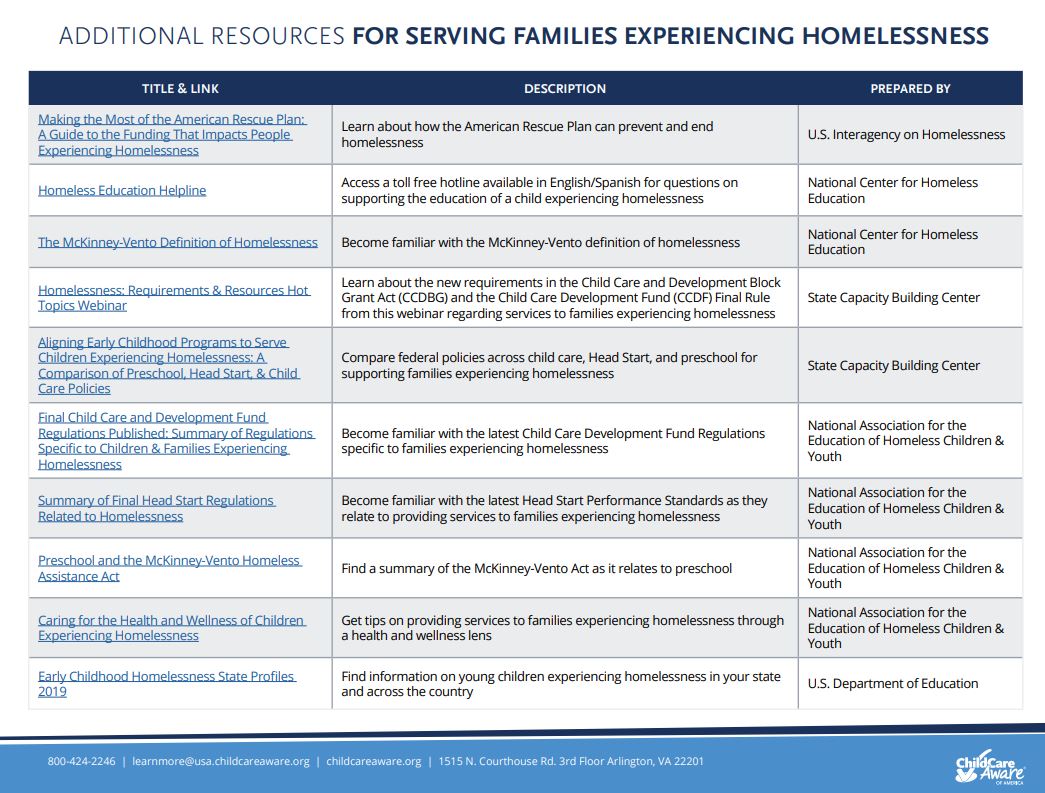

More than one million children under the age of six are identified as experiencing homelessness. As job and income loss continues because of the COVID-19 economy, and as the COVID-19 eviction protections expire many more children and families may be at risk. These children and families find themselves in a particularly vulnerable situation during the COVID-19 pandemic. Along with the typical stressors of being homeless, or on the verge of homelessness, families must deal with the additional risk of contracting the virus due to lack of social distancing in shelters or other gathering places and lack of access to masks and other personal protective devices.
Reaching out to and supporting staff, families and children who are experiencing homelessness or who are at risk of becoming homeless is more important now than ever due to the additional risks that COVID-19 presents. CCR&Rs and child care programs have an important role in ensuring that staff, families and children have the supports and resources they need.
Keep the following in mind when exploring how homelessness and housing instability might impact your staff and the families they serve and how it can impact the risk of contracting COVID-19:
- Stability–Support continuity of care, both caregiving by staff and care of children. Are there proactive practices in place to remain aware of housing status transitions, including impending or potentially preventable changes? What can help staff and families to remain at work and in the program?
- Density–Be aware of changes in density and any overcrowding that can make social distancing and sanitary precautions more difficult for staff and families. Are there practices in place to keep staff and family household composition information up to date, including who resides in the households and any changes to its members? How can you identify if staff or families move from a less dense to a more dense multi–family setting or a shelter?
- Vulnerability–Be aware of changes in close contacts. Does a housing status transition introduce staff or families to anyone who is elderly, ill, or otherwise compromised?
- Resources –Be aware of staffs’ and families’ changing needs for protective health supplies and basic needs items to remain healthy and strong. Are sanitary supplies, protective equipment, food, etc. made available for those experiencing financial stress due to decreased hours of work, insufficient unemployment compensation for a family member, etc.? Can programs become a hub for another community agency, including schools, for distribution of needed resources and supports to staff and families?
Child care program staffs’ regular and authentic connection with families currently served is one way to build a trusting environment in which families are more likely to share news such as housing status transitions. Use the following strategies to enhance current efforts to support families (and staff members) whose living arrangements may be disrupted.
Strategies for CCR&Rs and Child Care Providers to consider:
- Create strong foundational expertise about family homelessness, rental assistance, and eviction protections
-
- Understand the criteria for eligibility based on the definition homelessness. One way to learn more is to complete the Supporting Children and Families Experiencing Homelessness interactive learning series created by the National Center on Parent, Family, and Community Engagement. The 8 learning modules can be found here.
- Implement internal protocols and practices to recognize housing instability/mobility among staff and participating families.
- Become familiar with the NCHE Helpline. The helpline is available for assistance with an issue related to the education of children experiencing homelessness. The helpline is toll free at (800)308-2145 – assistance is available in English and Spanish.
- Understand the federal, state, and local eviction moratoriums in place in your community, and the steps renters need to take to receive these protections. One way to learn is the new one-pager: Tips for CCR&RS: What to Know About Helping Renters.
- Check to see if there is expanded rental assistance available in your state or community here.
- Connect people to information on legal eviction and rental protections here/
- Ensure clear understanding of state/local CCDF guidance regarding family homelessness and COVID-19
-
- What are your state/local regulations and accommodations for those who meet homeless eligibility criteria?
- What state/local CCDF modifications regarding COVID-19 and any special accommodations around homelessness have been made?
- What other state/local resources are available, for example, CCR&Rs, Child Care Health Consultant supports, Child and Adult Care Food Program services, etc.
- Facilitate the development of directories/packets/bulletin boards of community resources and supports
-
- Community resource grids are an excellent way to make local resources visible to members of the program staff and the families served. For examples of who to establish partnerships with and what strategies to use, see specifically Modules 5 and 8 of the Supporting Children and Families Experiencing Homelessness interactive learning series created by the National Center on Parent, Family and Community Engagement. The 8 learning modules can be found here.
-
- CCR&Rs and child care programs may use these materials to train staff and support families.
- Promote physical and emotional self-care space for staff and parents, while being sensitive to diversity and individual preferences
-
- Rethink environments, schedules and opportunities to ensure basic needs are met.
- Establish partnerships to provide material supports and resources, e.g., schools, human service agencies, churches, community groups, etc.
CCR&Rs and child care programs can help to play a role in providing supports for families and staff who are experiencing homelessness, and thus at enhanced risk of getting COVID-19. CCR&Rs can request technical assistance from the Emergency Child Care & Technical Assistance Center™. Here is a document with a list of additional resources to support your learning.



